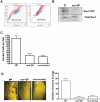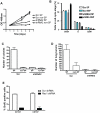Rac1 targeting suppresses human non-small cell lung adenocarcinoma cancer stem cell activity
- PMID: 21347385
- PMCID: PMC3036726
- DOI: 10.1371/journal.pone.0016951
Rac1 targeting suppresses human non-small cell lung adenocarcinoma cancer stem cell activity
Abstract
The cancer stem cell (CSC) theory predicts that a small fraction of cancer cells possess unique self-renewal activity and mediate tumor initiation and propagation. However, the molecular mechanisms involved in CSC regulation remains unclear, impinging on effective targeting of CSCs in cancer therapy. Here we have investigated the hypothesis that Rac1, a Rho GTPase implicated in cancer cell proliferation and invasion, is critical for tumor initiation and metastasis of human non-small cell lung adenocarcinoma (NSCLA). Rac1 knockdown by shRNA suppressed the tumorigenic activities of human NSCLA cell lines and primary patient NSCLA specimens, including effects on invasion, proliferation, anchorage-independent growth, sphere formation and lung colonization. Isolated side population (SP) cells representing putative CSCs from human NSCLA cells contained elevated levels of Rac1-GTP, enhanced in vitro migration, invasion, increased in vivo tumor initiating and lung colonizing activities in xenografted mice. However, CSC activity was also detected within the non-SP population, suggesting the importance of therapeutic targeting of all cells within a tumor. Further, pharmacological or shRNA targeting of Rac1 inhibited the tumorigenic activities of both SP and non-SP NSCLA cells. These studies indicate that Rac1 represents a useful target in NSCLA, and its blockade may have therapeutic value in suppressing CSC proliferation and metastasis.
Conflict of interest statement
Figures







References
-
- Jemal A, Siegel R, Ward E, Murray T, Xu J, et al. Cancer statistics, 2006. CA Cancer J Clin. 2006;56:106–130. - PubMed
-
- Lapidot T, Sirard C, Vormoor J, Murdoch B, Hoang T, et al. A cell initiating human acute myeloid leukaemia after transplantation into SCID mice. Nature. 1994;367:645–648. - PubMed
-
- Singh SK, Hawkins C, Clarke ID, Squire JA, Bayani J, et al. Identification of human brain tumour initiating cells. Nature. 2004;432:396–401. - PubMed
-
- O'Brien CA, Pollett A, Gallinger S, Dick JE. A human colon cancer cell capable of initiating tumour growth in immunodeficient mice. Nature. 2007;445:106–110. - PubMed
Publication types
MeSH terms
Substances
Grants and funding
LinkOut - more resources
Full Text Sources
Medical
Research Materials

